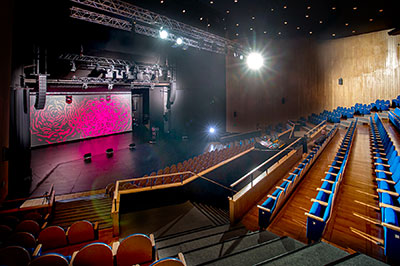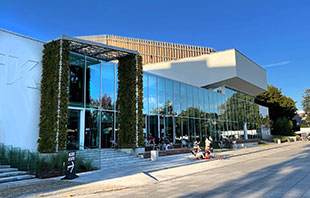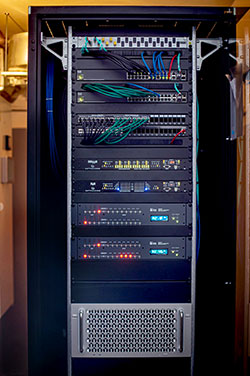Poland’s largest dramatic theatre has reopened after lockdown, to reveal a major renovation to its various spaces. The project, which took eight months to fulfil, included the renewal of the main building façade, the entrance and surroundings, modernisation of stages and auditorium, as well as sound and lighting systems. This included a complete Optocore fibre network, based around five AutoRouters, along with several DiGiCo mixing consoles.
 In order to preserve its impressive heritage, the Jan Kochanowski Theatre in Opole (JK Opole Theatre) need full modernisation, and a thorough overhaul of its technical infrastructure, fulfilling a dream it had nurtured for several years. The cost of reconstruction – which took up much of 2021 – was budgeted at 25m złoty (nearly US$6m), with more than half coming from EU funds.
In order to preserve its impressive heritage, the Jan Kochanowski Theatre in Opole (JK Opole Theatre) need full modernisation, and a thorough overhaul of its technical infrastructure, fulfilling a dream it had nurtured for several years. The cost of reconstruction – which took up much of 2021 – was budgeted at 25m złoty (nearly US$6m), with more than half coming from EU funds.
The theatre layout itself includes the 575-seat Big Stage (Duża Scena), with an impressive revolving stage; Small Stage (Mała Scena) with 193 seats, in amphitheatre auditorium style; a ground floor stage known as the Bunker, and a Model Workshop (Modelatornia), with 140 seats in customisable configuration. This was where the notion of modernising the theatre’s electroacoustic system first began in 2017 with the possibility of producing sound from each side, in any configuration.
As part of this project, a new theatre façade was made, and the ventilation and air conditioning system and part of the electrical installation of the building were modernised. At the same time, the Center for Theater Education was also established. A new stage lighting for the Small Stage was delivered, its acoustics were improved and the electroacoustic system of all stages was modernised at the hands of well-known technical integrators, M Ostrowski.
 ‘The modernisation of the TJK technical facility was no easy task,’ says Audio Design Engineer and Project Manager, Paweł Francuz. ‘The theatre building is a huge facility, with several rooms, requiring a complicated layout of the cable routes from the central control room on Level -2 – the hub of the entire signal distribution system to the electroacoustic system. The task was not facilitated by the coronaviruspandemic, as a result of which we had to stop work, and the delivery of some of the devices manufactured overseas was delayed.’
‘The modernisation of the TJK technical facility was no easy task,’ says Audio Design Engineer and Project Manager, Paweł Francuz. ‘The theatre building is a huge facility, with several rooms, requiring a complicated layout of the cable routes from the central control room on Level -2 – the hub of the entire signal distribution system to the electroacoustic system. The task was not facilitated by the coronaviruspandemic, as a result of which we had to stop work, and the delivery of some of the devices manufactured overseas was delayed.’
In designing the new infrastructure, M Ostrowski specified a DiGiCo/Optocore combination, as the quality and functionality of the mixing and network distribution system became their top priority.
The digital transmission of audio signals, broadcast through Meyer Sound PA systems, is based on creating an autonomous Optocore fibre-optic network for each stage of the theatre. It operates in a redundant five-point star topology – independently for each scene – to create full communication between each location (30 in total). This has been made possible by the deployment of five Optocore AutoRouters, further supported by a redundant Dante network. These are equipped with Neutrik OpticalCon Duo sockets to carry out the function of combining individual scenes with each other in any configuration, remotely, without interfering with the structure of fibre-optic network connections.
The five AutoRouters are configured and implemented as follows: the first AutoRouter 40 Duplex multimode LC is responsible for signal distribution between devices operating within the Big Stage; a second AutoRouter 30 is responsible for signal distribution between devices operating within the Modelatornia; a third AutoRouter 20 takes care of signal distribution within the Small Stage, while a fourth AutoRouter 20 handles signal distribution within the Stage environment on the Ground Floor (Bunker). Finally, the fifth AutoRouter 10 serves as the master zone router, responsible for connecting all the other AutoRouter interfaces; using the dedicated Optocore Control Software it automatically coordinates scene connectivity, either individually or in any configuration, by default.
T he Duża Scena has a DiGiCo SD10-24T console with an SD9T, usually resident in the Modelatornia stage, also available when necessary. Additionally, there are three SD11s, one of which is permanently installed in the control room of the Mała Scena and another in The Bunker. The third SD11 is used for additional tasks such as streaming and recording. Two SD-Racks are installed along with six SD-MiNi Racks, which are used as mobile input boxes. A total of four bi-directional DiGiCo Orange Box converters, permanently installed in each stage, allow for bi-directional channel conversion via Optocore and DANTE, enabling two-way transmission with almost negligible latency. This applies to both the console-stage rack transmission and the console-console transmission.
he Duża Scena has a DiGiCo SD10-24T console with an SD9T, usually resident in the Modelatornia stage, also available when necessary. Additionally, there are three SD11s, one of which is permanently installed in the control room of the Mała Scena and another in The Bunker. The third SD11 is used for additional tasks such as streaming and recording. Two SD-Racks are installed along with six SD-MiNi Racks, which are used as mobile input boxes. A total of four bi-directional DiGiCo Orange Box converters, permanently installed in each stage, allow for bi-directional channel conversion via Optocore and DANTE, enabling two-way transmission with almost negligible latency. This applies to both the console-stage rack transmission and the console-console transmission.
‘DiGiCo was chosen because it can be routed freely via the Optocore fibre network, it delivers the highest quality audio, and its theatre specific ‘T’ software is a great tool for sound engineers working on theatrical or operatic productions,’ explains the theatre’s sound engine, Robert Kondziela. ‘There are also practically unlimited possibilities to integrate DiGiCo devices with devices from other manufacturers such as Waves and Klang, along with its integration with immersive sound systems, Dante network and much more.’
The DiGiCo SD series consoles and stageracks are fitted with Optocore DD32R and X6R-TP fibre interfaces, which route the main PA feed to the Galileo processor. This enables bi-directional, low-latency transmission of up to 1,024 audio channels forboth theconsole-to-stagerack and console-to-console transmission.
The total analogue I/O available is 256 inputs and 136 outputs with additional I/O built into each console, which can be freely assigned (taking into account the number of channels supported by individual consoles). The Optocore interfaces are responsible for receiving and transmitting signals from and to stage connections and receiving signals from wireless systems.
An additional solution used in connection with the transmission of digital audio signals, is a set of Optocore-Dante converters allowing for the transmission of a total of 256 input channels and 256 output channels between networks. This concept assumed the possibility of redundant transmission of ‘everything everywhere’. The provision of such a large number of digital I/O channels ensures simultaneous implementation of all functions, including safe signal transmission within a single (or many) scenes, multitrack recording and streaming, and integration with sound mixing systems from other manufacturers. Again, all functions can be performed simultaneously.
More: www.optocore.com

